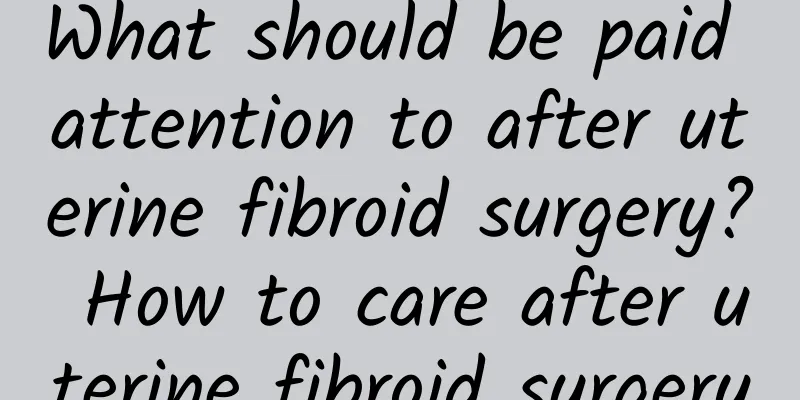What should be paid attention to after uterine fibroid surgery? How to care after uterine fibroid surgery

|
Uterine fibroids are a common gynecological disease. After surgery, patients should do relevant basic care and understand some preventive measures to help the body recover as soon as possible. So, what aspects should be mastered after uterine fibroid surgery? How to deal with pain? Let's take a look at the relevant introduction. Four points to master in postoperative care of uterine fibroids 1. Basic nursing In the early postoperative period, family members should often stay by the bedside, closely observe the patient's vital signs, and pay special attention to changes in body temperature; frequently ask the patient whether he or she has other discomforts, such as nausea, abdominal pain, etc.; and carefully observe whether there is any dressing leakage from the incision. Careful surgical wound care: After uterine fibroid surgery, the patient's surgical wound is generally at the navel, about 1 cm long. Keep the wound clean and dry after surgery, and do not scratch it at will. The wound usually heals ten days after surgery. During this period, avoid showering and other wet wounds. Pay attention to vaginal bleeding: In clinical hysterectomy, in order to more clearly examine the ovaries, fallopian tubes and uterus and facilitate the operation, doctors usually place a uterine support device in the patient's vagina (commonly used for married women with uterine fibroids). The operation may cause a small amount of vaginal bleeding after the operation. If there is only a small amount of vaginal bleeding and it returns to normal quickly, it is a normal phenomenon. However, if the bleeding lasts for more than two weeks, you need to return to the hospital in time. Develop a regular daily routine: After uterine fibroid surgery, patients need adequate rest and a light diet to help with recovery. If recovery is good, patients can resume normal work and rest rules within 7 days after surgery. Patients who used to like staying up late should strictly discipline themselves and develop a healthy and reasonable work and rest schedule for themselves. Moderate exercise: Usually, when patients recover well 50 days after uterine fibroid surgery, they will choose the exercise that suits them according to their physical condition and stick to exercising to help strengthen their physical fitness. Pay attention to balanced nutrition: The formation of uterine fibroids is directly related to daily diet, so patients also need to pay more attention to diet after surgery. Pay attention to comprehensive and balanced nutrition intake. After surgery, you can drink an appropriate amount of water to replenish the loss of body fluids during surgery; high-protein foods can accelerate wound healing, or you can eat more after surgery. In particular, we must avoid all spicy and irritating foods that cause bloating. Eat more foods that moisten the intestines and promote bowel movements: Eat more whole grains such as whole grains, as well as foods rich in high fiber, to help moisten the intestines and keep bowel movements smooth. Within six months after surgery, patients should try to avoid physical labor that increases abdominal pressure, such as without heavy objects. 2. Pain care In the early postoperative period, patients usually experience incision pain. At this time, family members should help patients distract their attention from the pain, chat with them more, and let them listen to soothing music; on the second day after surgery, patients can be helped to take a semi-recumbent position to relieve pain. If the pain is severe, analgesics can be given according to the doctor's advice. Incision pain Generally speaking, there may still be slight hanging pain at the incision in the abdomen when you are discharged from the hospital. It is normal to have needle pain from time to time. If the incision pain is obvious, you need to check whether it is red and swollen to rule out the possibility of infection. If there is pus squeezed out, you need to go to the hospital for a dressing change. Only redness and swelling can buy an infrared bulb and install it on the base of the table lamp. After proper placement, irradiate the abdomen twice a day for 20 minutes each time, and it is best not to feel hot. Painful urination Most patients will not have this symptom. A few may have radiating pain in the lower abdomen, which may be caused by surgery. Because the uterus and bladder are adjacent, such as pelvic adhesions, the removal of the uterus and bladder separation may cause some abrasions. After a few days, usually drink more boiling water, consciously urinate immediately, and don't hold urine for too long. If the urethra is painful, it may be caused by urethral infection. Mild patients drink more boiling water every day, and severe patients need to go to the hospital for further examination and treatment. Lower back pain Mild pain usually improves on its own after a few days of rest. If the pain is significant, you need to go to the hospital and ask the doctor to eliminate the sequelae left by the anesthesia and use some medicine if necessary. 3. Vulva care Patients with uterine fibroids should pay special attention to vulva care after surgery, clean it regularly, dry it with a special towel, keep the vulva dry and hygienic, and wash underwear frequently. 4. Psychological care Medical staff can publicize relevant knowledge about uterine fibroids to patients and their families, eliminate their concerns, enhance their determination and confidence to overcome the disease, and cooperate with treatment to promote physical recovery. Precautions after uterine fibroid surgery 1. Avoid pregnancy: After uterine fibroid surgery, the uterus is still in the recovery period. Do not rush to get pregnant within a short period of time after surgery. 2. Light diet: After uterine fibroid surgery, patients should avoid all spicy foods, eat more fresh fruits and vegetables, and avoid hot, blood-clotting and cold foods. 3. Pay attention to hygiene: Carefully care for the surgical wound and avoid irritating or scratching the wound. Keep the surgical wound clean and dry. At the same time, pay attention to the cleanliness of the genital vulva, wear cotton and breathable tight underwear, and clean and replace it in time. 4. Timely follow-up: After surgery for uterine fibroids, you need to follow the doctor's advice and follow up regularly. The doctor will observe and treat according to the recovery status and degree after surgery. Due to the high incidence of uterine fibroids, follow-up work should be done even after recovery. 5. Stop sexual life after surgery: Stop sexual life for 3 months after uterine fibroid surgery to give the uterus enough time to recover. Only after recovery can sexual life be resumed. 6. Maintain a regular work and rest schedule: After uterine fibroid surgery, pay attention to adjusting your personal work and rest schedule and regularity. Do not stay up late and fatigue, which will cause a disorder of the biological clock. This is very unfavorable for postoperative recovery. 7. Avoid strenuous exercise: Avoid strenuous exercise after surgery to avoid irritating the wound. Such as riding, cycling, jumping, sitting for a long time, standing for a long time, etc. These actions can cause pelvic congestion and lead to various discomforts in the future. At the same time, pay attention to excessive fatigue and avoid heavy objects, which will increase the burden on the abdomen and affect recovery. 8. Drink plenty of water. In addition to paying attention to a light diet and nutrition, you should also pay attention to replenishing your body's water in time every day. 9. Pay close attention to abnormal symptoms: Uterine fibroid surgery may cause a small amount of vaginal bleeding, but if vaginal bleeding continues for more than 2 weeks, you should go to the hospital for follow-up in time. |
Recommend
How to do painless microtubule abortion
With the openness of modern society, more and mor...
What causes recurrent pelvic peritonitis?
Chronic pelvic peritonitis is usually caused by i...
Causes of abnormal itching of vaginal discharge
Abnormal vaginal discharge accompanied by itching...
What are the specific causes of ovarian cysts?
Ovarian cysts are a very harmful gynecological di...
Does cervical erosion and hypertrophy affect pregnancy?
Cervical erosion and hypertrophy themselves usual...
What to eat to nourish the body after abortion? Is drinking soup good for the body after abortion?
After an abortion, women's bodies are damaged...
Can’t stop eating French fries and potato chips before going to bed? Can’t control your cravings? 4 Tips to Effectively Suppress Appetite
Why do some people always like to eat snacks befo...
What should I do if I have abnormal menstruation after taking birth control pills?
What should I do if I have abnormal menstruation ...
Is it dangerous to have a miscarriage of the first child? 4 possible dangers after miscarriage
Women who have a miscarriage will have a period o...
Expert introduction: What to avoid eating when suffering from dysmenorrhea
What are the main things to pay attention to in t...
Can the three-line sign rule out intrauterine adhesions?
The three-line sign generally refers to the three...
How to confirm that it is ovulation bleeding?
How to confirm that it is ovulation bleeding? Ovu...
What are the main causes of cervicitis?
Cervicitis is a common gynecological disease, mai...
How to treat the causes of uterine prolapse?
The causes of uterine prolapse are generally birt...
My period came one week early and I have a little bleeding. What should I do?
My period came one week early and I have a little...









